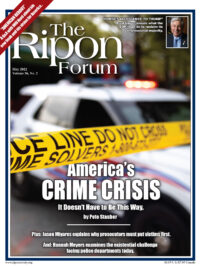
As nationwide crime rates surge—at least 16 cities broke homicide records in 2021 — police departments need capable and coolheaded cops. But officer retirements and resignations have surged in the past two years, and it’s become harder for many agencies to recruit quality candidates — or any at all.
In New York City, over 5,300 NYPD uniformed officers resigned or retired in 2020 — a 75% spike over the previous year. The department reportedly had to cap the number who could file papers simultaneously so as not to overwhelm the system. In Minneapolis, 105 officers left the department in 2020: more than double the average attrition rate. Seattle hemorrhaged 180 officers in 2020 and 170 in 2021 — a near doubling of the 95 officers who left in 2019. In Chicago, 660 cops retired in 2021, nearly twice as many as in 2018. And California’s police staffing crisis reportedly has Bay Area departments unable to fill hundreds of positions. Oakland PD lost a record-breaking 86 officers in 2021 and 2022 is on pace to be worse. And the San Francisco PD is reportedly suffering from a significant deficit among even non-sworn professional staff.
Officer retirements and resignations have surged in the past two years and it’s become harder for many agencies to recruit quality candidates — or any at all.
Why don’t cops want to stay on the job and why don’t others want to enter it? Among other reasons, the work has become more dangerous and less gratifying.
The increased risk is both physical and reputational. Following the 2020 death of George Floyd, a tsunami of anti-police sentiment confronted cops from the public, the media, and policymakers. The ideas that police are blanketly racist and cause more harm than good dominated public discussion.
In this environment, individual officers increasingly experienced life-altering vilification even when they had done nothing wrong. When Columbus, Ohio officer Nicholas Reardon shot Ma’Khia Bryant as she attempted to stab another girl in April 2021, he was met with a campaign of abuse. Joe Biden’s White House claimed the shooting underscored policing’s systemic racism and U.S. Senators Cory Booker and Raphael Warnock cited Reardon’s actions as demonstrating the need for police overhaul. Many responses were more personal and menacing: NBA star LeBron James tweeted, “YOU’RE NEXT #ACCOUNTABILITY,” with an hourglass emoji over a photo of an officer at the shooting scene. All this — although Reardon was not even charged. His actions were deemed justifiable homicide, protecting an innocent girl. Officers in similar conditions nationwide have found themselves and their families the targets of threats and abuse.
Meanwhile, police have become at greater risk of physical harm from hesitating in moments of confrontation. After Minneapolis Officer Derek Chauvin was charged with murdering George Floyd by pinning him under his knee, jurisdictions rushed to adopt often overlapping and confusing bans on chokeholds. In New York, for instance, the City Council passed and then-mayor Bill de Blasio signed legislation enhancing an existing ban, enabling prosecutors to bring misdemeanor charges against officers if they used any move during an arrest that restricted the person’s breathing “in any way.”
The ambiguity of this language left cops terrified to grapple with suspects lest they unknowingly expose themselves to legal liability. This law was so irresponsibly crafted that it was struck down in June 2021 by a Manhattan Supreme Court judge for being “unconstitutionally vague.” However, many similar laws remain on the books, making officers more hesitant when struggling with violent suspects, exposing themselves and those around them to a greater risk of harm.
Why don’t cops want to stay on the job and why don’t others want to enter it? Among other reasons, the work has become more dangerous and less gratifying.
Changes in prosecution practices have also demoralized officers. In many cities, “progressive” prosecution policies adopted by legislatures or through the discretion of individual district attorneys have essentially decriminalized whole crime categories. In New York State, bail “reform” laws passed in 2019 and tweaked the following year greatly reduced the consequences for shoplifting—emboldening thieves. In just the first two months of the 2020 laws, the re-arrest rate for repeat commercial burglars was 59%, and for second-degree robbery, 38%. Retail theft skyrocketed in New York City, where complaints jumped 36 percent from 2020 to 2021, a trend that has continued with the announcement in January by new Manhattan DA Alvin Bragg that robberies will be treated as shoplifting – and shoplifting will essentially not be prosecuted. No wonder, year-to-date, robberies are up over 50% citywide from this time in 2019.
Simultaneously, the ability for police to resolve these crimes has dropped. The “clearance” rate for larceny theft plummeted from 20.2% in 2019 to 11.6% in 2020, although it inched up several percentage points by the end of 2021. So police are faced with a depressing reality: as vigilant as they may be in arresting shoplifters, they will likely see the same individual (and ever more individuals like him) back out on the street immediately, pilfering from the same stores.
In this climate, what can departments do to staunch attrition? My colleague Robert VerBruggen has argued that in an unfriendly political and policy environment, assurances of fair treatment and support from departments and government officials can bolster officer morale. Such assurances can help convince officers to still take on their job proactively, confident of agency backing should they have to use force. Former longtime Milwaukee Police Chief Ed Flynn has argued that police executives can increase officers’ sense of fulfillment by recognizing that even entry-level patrolmen routinely act as leaders: they have authority to make decisions in high-pressure, complex, and ambiguous situations while the world watches to see if they act impartially. Flynn urges creating and disseminating a climate of ethical leadership to build a more attractive agency culture—that is also better for policed communities.
In the short-term, agencies nationwide are scrambling to overcome their short staffing with creative new initiatives to attract recruits. The Chicago Police Department is piloting a streamlined recruitment program to entice U.S. marines to move to Chicago and join the department. The Asheville Police Department, reporting record low staffing, is offering a two-year $225,000 contract to new hires and have brought in an outside firm to help with recruitment. The Baltimore Police Department, struggling with retention and recruitment, is planning to pioneer hiring civilians to investigate low-level crimes, internal affairs complaints and cold cases.
Police departments will need to convince recruits that being a cop is worth the increased dangers and will still be gratifying work even when offenders are cycled right back out to commit more crime. However, until criminal justice policies and political posturing shift, it’s going to be an uphill battle.
Hannah E. Meyers is director of policing and public safety at the Manhattan Institute.




